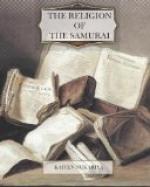Zen is based on the highest spiritual plane attained by Shakya Muni himself. It can only be realized by one who has attained the same plane. To describe it in full by means of words is beyond the power even of Gotama himself. It is for this reason that the author of Lankavatara-sutra insists that Shakya Muni spoke no word through his long career of forty-nine years as a religious teacher, and that of Mahaprajnyaparamita-sutra[FN#108] also express the same opinion. The Scripture is no more nor less than the finger pointing to the moon of Buddhahood. When we recognize the moon and enjoy its benign beauty, the finger is of no use. As the finger has no brightness whatever, so the Scripture has no holiness whatever. The Scripture is religious currency representing spiritual wealth. It does not matter whether money be gold, or sea-shells, or cows. It is a mere substitute. What it stands for is of paramount importance. Away with your stone-knife! Do not watch the stake against which a running hare once struck its head and died. Do not wait for another hare. Another may not come for ever. Do not cut the side of the boat out of which you dropped your sword to mark where it sunk. The boat is ever moving on. The Canon is the window through which we observe the grand scenery of spiritual nature. To hold communion directly with it we must get out of the window. It is a mere stray fly that is always buzzing within it, struggling to get out. Those who spend most of their lives in the study of the Scriptures, arguing and explaining with hair-splitting reasonings, and attain no higher plane in spirituality, are religious flies good for nothing but their buzzing about the nonsensical technicalities. It is on this account that Rin-zai declared:[FN#109] ’The twelve divisions of the Buddhist Canon are nothing better than waste paper.’
[FN#108] Mahaprajnyaparamita-sutra, vol. 425.
[FN#109] Rin-zai-roku.
2. No Need of the Scriptural Authority for Zen.




